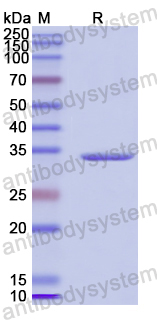Catalog No.
YHJ64201
Expression system
E. coli
Species
Homo sapiens (Human)
Protein length
Gly699-Ser976
Predicted molecular weight
34.15 kDa
Nature
Recombinant
Endotoxin level
Please contact with the lab for this information.
Purity
>90% as determined by SDS-PAGE.
Accession
Q9NQ38
Applications
ELISA, Immunogen, SDS-PAGE, WB, Bioactivity testing in progress
Form
Lyophilized
Storage buffer
Lyophilized from a solution in PBS pH 7.4, 0.02% NLS, 1mM EDTA, 4% Trehalose, 1% Mannitol.
Reconstitution
Reconstitute in sterile water for a stock solution. A copy of datasheet will be provided with the products, please refer to it for details.
Shipping
In general, proteins are provided as lyophilized powder/frozen liquid. They are shipped out with dry ice/blue ice unless customers require otherwise.
Stability and Storage
Use a manual defrost freezer and avoid repeated freeze thaw cycles. Store at 2 to 8°C for frequent use. Store at -20 to -80°C for twelve months from the date of receipt.
Alternative Names
Lympho-epithelial Kazal-type-related inhibitor, SPINK5, LEKTI, Serine protease inhibitor Kazal-type 5
[Clinical feature and genetic analysis of a preterm infant with Netherton syndrome due to variants of SPINK5 gene]., PMID:40372225
Blocking of IL-4/IL-13 Signalling With Dupilumab Results in Restoration of Serum and Cutaneous Abnormalities in Netherton Syndrome., PMID:40344324
Syndromic epidermal differentiation disorders: New classification towards pathogenesis-based therapy., PMID:40184496
Abrocitinib alleviates the symptoms of Netherton syndrome and is well tolerated., PMID:40159127
Finding Potential Drug Targets for Pre-Eclampsia Using Mendelian Randomisation and Colocalisation Analysis., PMID:40028697
Targeting kallikrein proteases for dandruff therapy., PMID:39707892
Plasma Proteome Alterations of Laying Hens Subjected to Heat Stress and Fed a Diet Supplemented with Pequi Oil (Caryocar brasiliense Camb.): New Insights in the Identification of Heat Stress Biomarkers., PMID:39595600
SPINK5 is a key regulator of eosinophil extracellular traps in head and neck squamous cell carcinoma., PMID:39508915
Molecular analysis of inherited disorders of cornification in polish patients show novel variants and functional data and provokes questions on the significance of secondary findings., PMID:39501396
Developing a Core Outcome Set for Netherton Syndrome: An International Multi-Stakeholder e-Delphi Consensus Study., PMID:39496226
Rapid identification of primary atopic disorders (PAD) by a clinical landmark-guided, upfront use of genomic sequencing., PMID:39381601
Malignant Transformation of Normal Oral Tissue to Dysplasia and Early Oral Squamous Cell Carcinoma: An In Silico Transcriptomics Approach., PMID:39376501
Development of a biomarker-based platform for comprehensive skin characterization using minimally invasive skin sampling and quantitative real-time PCR., PMID:39141418
LEKTI domain 6 displays anti-inflammatory action in vitro and in a murine atopic dermatitis model., PMID:38849289
Development of a back-titration assay to quantitate functional lympho-epithelial Kazal-type inhibitors (LEKTI) in skin samples., PMID:38556114
Functional characterization of serine proteinase inhibitor Kazal-Type in the red claw crayfish Cherax quadricarinatus., PMID:38537926
SPINK5 inhibits esophageal squamous cell carcinoma metastasis via immune activity., PMID:38442944
Successful infliximab treatment in siblings with Netherton syndrome: Unveiling a novel SPINK5 gene variant and literature review., PMID:38419182
Netherton Syndrome with a Novel Likely Pathogenic Variant c.420del (p.Ser141ProfsTer5) in SPINK5 Gene: A Case Report., PMID:38406644
Comparative analyses of Netherton syndrome patients and Spink5 conditional knock-out mice uncover disease-relevant pathways., PMID:38316920
Translatome profiling reveals Itih4 as a novel smooth muscle cell-specific gene in atherosclerosis., PMID:38289873
Severe Hypernatremia as Presentation of Netherton Syndrome., PMID:38025195
EMT-related gene risk model establishment for prognosis and drug treatment efficiency prediction in hepatocellular carcinoma., PMID:37990105
Netherton Syndrome Caused by Heterozygous Frameshift Mutation Combined with Homozygous c.1258A>G Polymorphism in SPINK5 Gene., PMID:37239440
Clinical and genetic characterization of Netherton syndrome due to SPINK5 founder variant in Latvian population., PMID:37102386
Inhibition of the Tumor Suppressor Gene SPINK5 via EHMT2 Induces the Oral Squamous Cell Carcinoma Development., PMID:37071303
Netherton Syndrome in a Mother and Her Two Children., PMID:36893349
Prevalence of and risk factors for nutritional deficiency and food allergy in a cohort of 21 patients with Netherton syndrome., PMID:36705039
Biological treatments for pediatric Netherton syndrome., PMID:36619513
Weighted gene co-expression network analysis combined with machine learning validation to identify key hub biomarkers in colorectal cancer., PMID:36576616
Dupilumab improves clinical symptoms in children with Netherton syndrome by suppressing Th2-mediated inflammation., PMID:36569942
Dual antibody inhibition of KLK5 and KLK7 for Netherton syndrome and atopic dermatitis., PMID:36516271
Ustekinumab therapy for Netherton syndrome., PMID:36419401
Computational modelling predicts impaired barrier function and higher sensitivity to skin inflammation following pH elevation., PMID:36321871
Treatment of Netherton syndrome with dupilumab., PMID:36321361
Establishment of a mouse model of Netherton syndrome based on CRISPR/Cas9 technology., PMID:36301754
A recombinase polymerase amplification (RPA) combined with strip visualization method for RNA-based presumptive tests of saliva and vaginal secretion., PMID:36265335
Whole genome sequencing identifies candidate genes for familial essential tremor and reveals biological pathways implicated in essential tremor aetiology., PMID:36183486
Novel splice site mutation at the C-terminal of SPINK5 cause a unique Netherton syndrome phenotype mimicking pustular psoriasis., PMID:36165187
Photoprotective activities of Lignosus rhinocerus in UV-irradiated human keratinocytes., PMID:35987413
Lobelia chinensis Extract and Its Active Compound, Diosmetin, Improve Atopic Dermatitis by Reinforcing Skin Barrier Function through SPINK5/LEKTI Regulation., PMID:35955819
Aberrant serine protease activities in atopic dermatitis., PMID:35817663
The Pathogenesis of Giant Condyloma Acuminatum (Buschke-Lowenstein Tumor): An Overview., PMID:35562936
Genome-wide association study identifies kallikrein 5 in type 2 inflammation-low asthma., PMID:35487308
SPINK5 mutation and FLG gene deletion in an infant with Netherton syndrome., PMID:35438212
SPINK5 is a Tumor-Suppressor Gene Involved in the Progression of Nonsmall Cell Lung Carcinoma through Negatively Regulating PSIP1., PMID:35368958
The Lineage Differentiation and Dynamic Heterogeneity of Thymic Epithelial Cells During Thymus Organogenesis., PMID:35273595
A novel pathogenic variant in the corneodesmosin gene causing generalized inflammatory peeling skin syndrome with marked eosinophilia and trichorrhexis invaginata., PMID:35178752
SPINK5 is a Prognostic Biomarker Associated With the Progression and Prognosis of Laryngeal Squamous Cell Carcinoma Identified by Weighted Gene Co-Expression Network Analysis., PMID:35140453
Bioinformatics analysis reveals that ANXA1 and SPINK5 are novel tumor suppressor genes in patients with oral squamous cell carcinoma., PMID:35116500

